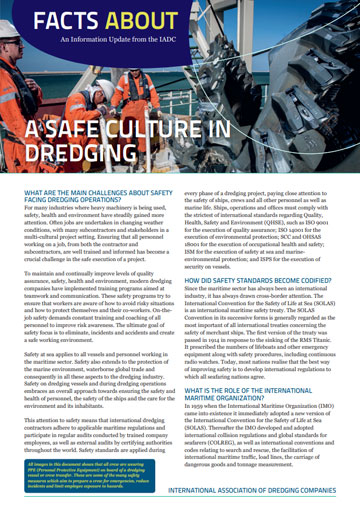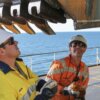“Facts About a Safe Culture in Dredging” describes international safety standards for the maritime industries and the pro-active initiatives of dredging contractors.
Since the maritime sector has always been an international industry, it has always drawn cross-border attention. The International Convention for the Safety of Life at Sea (SOLAS) was the very first treaty covering safety and is still regarded as the most important of all international maritime safety treaties. Since the 1950s the International Maritime Organization (IMO) has regulated safety standards that apply to all vessels and personnel working in the maritime sector as well as to the protection of the marine environment and waterborne global trade.
Safety on dredging vessels and during dredging operations embraces an overall approach towards ensuring the safety and health of personnel, the safety of ships and the quality of the environment which conform with these “Safety at sea” regulations. During every phase of a dredging project, close attention is given to the safety of ships, crews and other personnel as well as marine life. Dredging ships, operations and offices are expected to comply with the strictest of international standards regarding Quality, Health, Safety and Environment.
Other standards of quality, safety and environmental awareness are often defined by the list of ISO/SCC/OHSAS/ISM and ISPS certificates for which a company has been certified. ISO codes originate from the International Organization for Standards which provides a wide range of certification for safety and quality. These standards are developed according to the principles of voluntary, market-driven, industry-wide consensus and the views of all interest groups are taken into account.
Besides international and national safety regulations, the dredging industry has made the safety of personnel their top priority. Requirements for lifeboat training exercises, Personal Protective Equipment (PPE) and recordkeeping of safety measures on board a dredging ship are now routine. On-the-job safety initiatives have become the norm and management is well aware that this demands constant training and coaching of all personnel to improve risk awareness and to ensure the reduction of incidents and accidents.
“Facts About a Safe Culture in Dredging” answers essential questions such as:
- Is Safety during dredging operations important?
- How did Safety Standards become codified?
- What is the role of the International Maritime Organization?
- What are some of the national and international safety regulatory agencies?
- What is the SCC (Safety Checklist Contractors)?
- What is the ISPS Code?
- What is the role of the International Organization for Standardization?
- How was OHSAS created?
- What is the ISM code?
- How do dredging contractors approach the issue of Safety?
- How important are training programmes at dredging companies?
- What is PPE?
- How do dredging contractors ensure compliance with Safety regulations?
- What are the main challenges about Safety facing dredging contractors?
- Why does Safety remain such an urgent and important issue?




